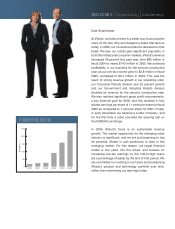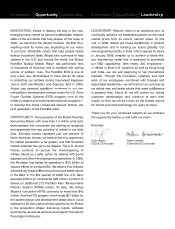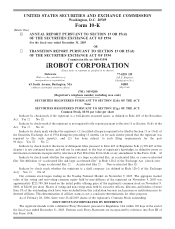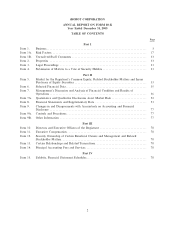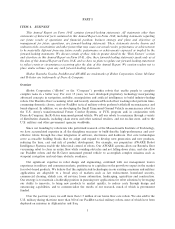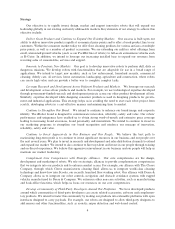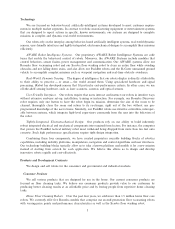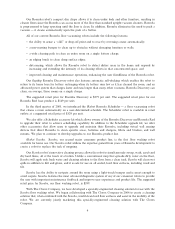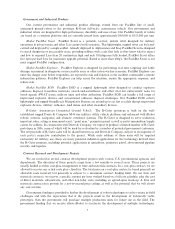iRobot 2005 Annual Report Download - page 12
Download and view the complete annual report
Please find page 12 of the 2005 iRobot annual report below. You can navigate through the pages in the report by either clicking on the pages listed below, or by using the keyword search tool below to find specific information within the annual report.While the U.S. government retains certain rights to military projects that it has funded, such as the right to
use inventions and disclose technical data relating to those projects without constraining the recipient's use of
that data, we retain ownership of patents and know-how and are generally free to develop other commercial
products, including consumer and industrial products, utilizing the technologies developed during these
projects. The rights which the government retains, however, may allow it to provide use of patent rights and
know-how to others, and some of the know-how might be used by these third parties for their own
development of consumer and industrial products. The contract development projects that we are currently
undertaking include:
Small Unmanned Ground Vehicle (SUGV). FCS is a major program intended to transform the
U.S. Army to be strategically responsive and dominant at every point on the spectrum of operations,
through real-time network centric communications and systems of a family of manned vehicles and
unmanned platforms by the next decade. The FCS program combines advanced technologies, organiza-
tions, people and processes with concepts to create new sources of military power that are more
responsive, deployable, agile, versatile, lethal, survivable and sustainable. The FCS system of systems is
designed to provide increased strategic responsiveness, adaptive modular organizations, and units of
action with three to seven days of self-sustainment.
Our specific role in the FCS program is to design and develop the SUGV, which is intended to be
the ""soldier's robot.'' The SUGV is expected to be a light-weight, man-portable robot that will support
reconnaissance, remote sensing and urban warfare. Our involvement in the FCS program has enabled us
to improve various management and control systems and enhance our engineering capabilities to achieve
the Software Executive Institute's Configuration Maturity Model, or CMM, certification Level III. The
program has also funded the development of earned value measurement and advanced modeling and
simulation.
NEOMover. New Explosive Ordnance Mover, or NEOMover, is a 200-pound gross weight tracked
vehicle, capable of transporting a 150-pound payload, with a small footprint and extremely high mobility
sponsored by the Technical Support Working Group, or TSWG. The NEOMover design incorporates a
number of concepts present in other iRobot remote controlled vehicles and demonstrates many of the
advantages that modular payloads and common interfaces can bring to the explosive ordnance disposal
community. There are two goals of this effort. The first is to advance the maturity levels of the
NEOMover hardware, firmware and software, and to enhance environmental ruggedness to a level
suitable for small quantity manufacturing and evaluation of NEOMover platforms in field trials. The
second is to maintain a level of architectural openness for future component integration with other
TSWG common architecture components to enable continued future development.
Wayfarer. Wayfarer is an applied research project funded by the U.S. Army Tank-automotive and
Armaments Command, or TACOM, to develop fully-autonomous urban reconnaissance capabilities for
our PackBot robot. On today's battlefields, urban reconnaissance is vital to the safety and effectiveness of
the soldier. Teleoperated robots can extend the soldier's vision, but their applications are limited by
communications range and available bandwidth. Wayfarer is being designed to increase the survival rates
and effectiveness of urban soldiers by extending their vision beyond communications range. Wayfarer
robots are being designed to perform the following fully-autonomous reconnaissance missions:
‚Route Reconnaissance. Move ahead of the soldier along a planned route of advance and return
maps and video of what lies ahead.
‚Perimeter Reconnaissance. Traverse the entire perimeter of a building complex and return with
maps and video.
‚Street-Based Reconnaissance. Navigate down city streets using street-following behaviors along
with GPS/INS and return maps and video of the urban terrain. The modular Wayfarer navigation
payload connects to the standard PackBot payload interface and includes light detection and
ranging, or LIDAR, stereo vision, forward-looking infrared, or FLIR, and inertial navigation
system sensor hardware.
8


